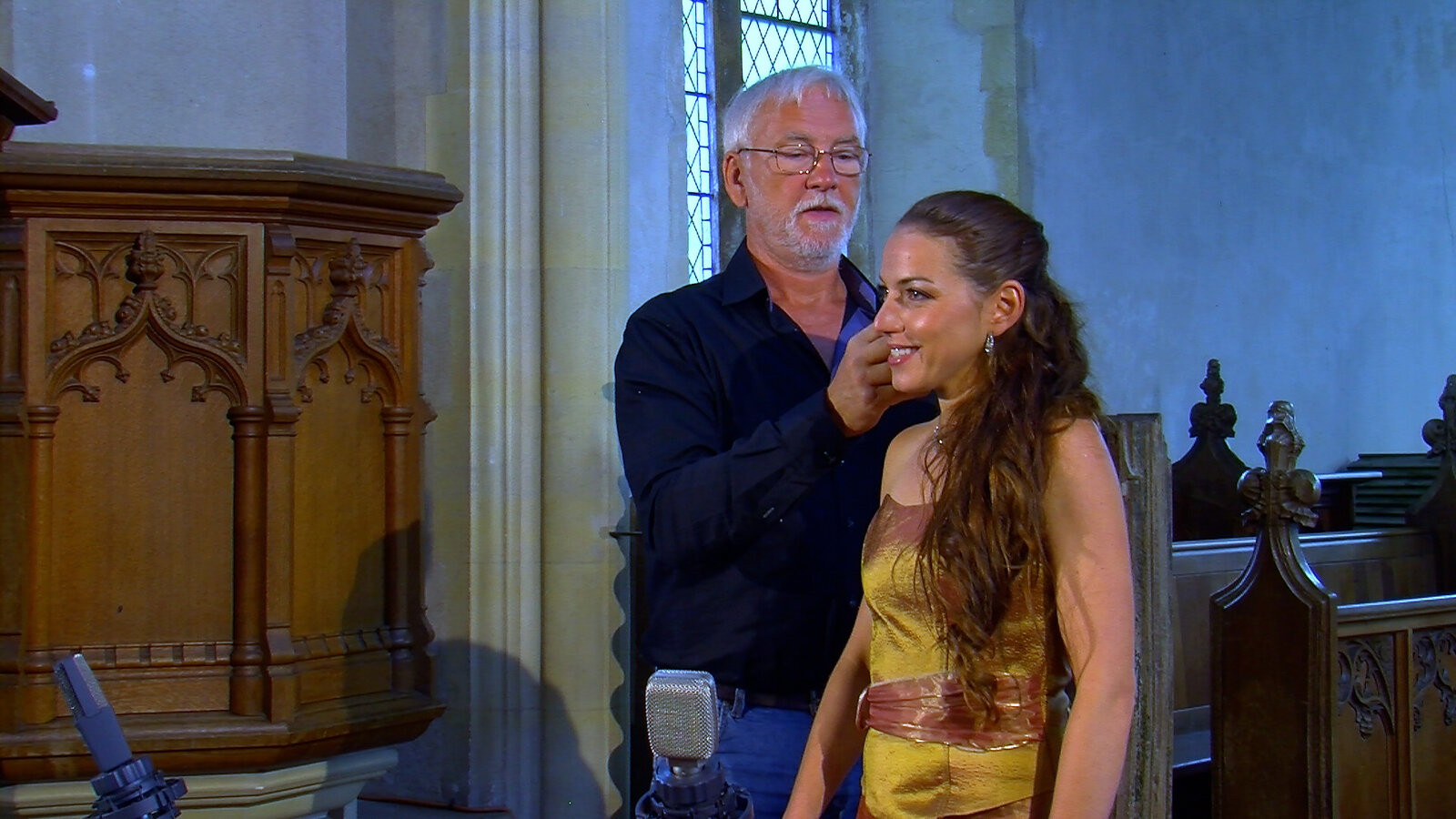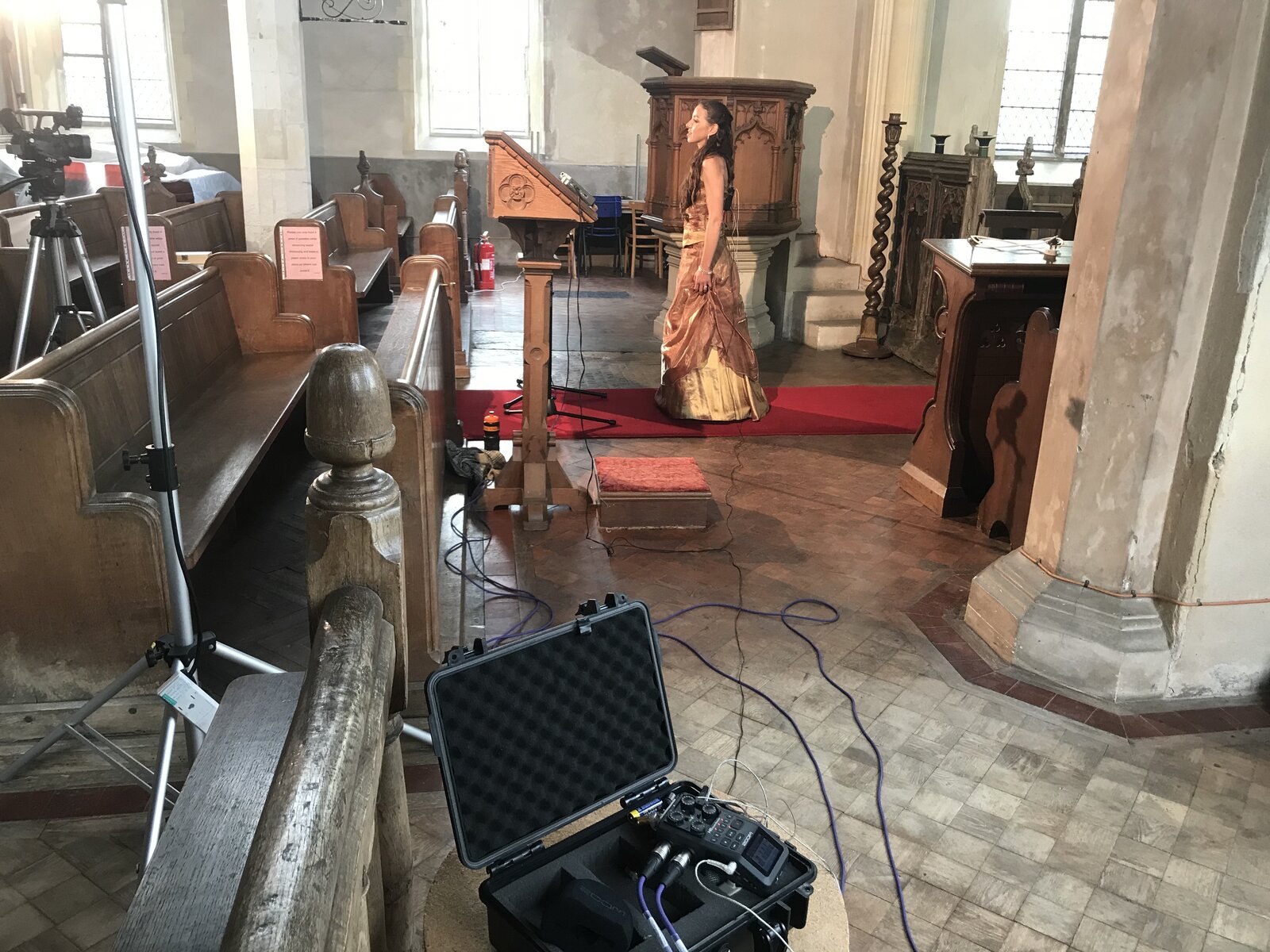I thought I'd share a little job I'm doing. Female opera singer needed some tracks recording for promotion. Hungarian singer, living in the UK with her pianist in Boston USA. A track recorded on an iPad in the US that works the wrong way around. For those not having bumped into classical recording, the singers work hard with their pianist, putting in tempo changes, small pauses and in this kind of music, the actual singing gets broken up with the pianist linking the verses together. Normally the pianist follows the singer, but with a track, they had to agree the pushes and pulls and then the singer has to follow the piano - NOT - the way they train in their studies. Then the recording turns into a video and audio recording. First snag is that the piano recording from the states was a fairly low quality mp3. I got the pianist to record it via MIDI and let me have the file. What I got was a GarageBand file! I don't use this, but stuck it on my MacBook. The files wouldn't load as they were IoS versions for phones and iPads, but I got it eventually into garage band to discover audio, not MIDI. Then I discovered garage band uses MIDI but doesn't have an export function. You can, however save the file as a loop, and this produces an .aif file, which you can then import into a small app (Google find it with a search for aif to midi converter search). Then I discovered it's 32bit only and of course my Mac is 64 bit only now. The mp3 was a very poor quality piano sound from garage band, so I desperately needed to get the MIDI and make it work on a decent sample set. I did in the end get the MIDI files, and then picked a suitable piano. Then I discovered the pianist's ebb and flow of tempo hadn't been recorded in the MIDI data, so it went out of sync. The cure, a manual tempo track adjustment, bar by bar using the waveform of the mp3, stretching and shrinking the MIDI tempo to fit.
I could not get the usual nice sounding churches close to me due to Covid concerns and rules, but found a smaller parish church with nice acoustics about 30 miles away with a friendly and understanding vicar.
Three cameras, some decent video lights, and a couple of zooms. One to playback the tracks into one in-ear hidden under the singers long hair, with a volume control clipped to the rear of her dress out of view. Mic wise, a simple mono setup, the usual one metre-ish distant. I selected one of my AKG 414s, a friendly classical mic, but I also thought I'd give a ribbon a try. I had a sample Chinese ribbon a couple of years ago and didn't find a use for it, but I wondered what it would work like. Difficult to assess there, so I used this on one side and the 414 on the other and picked one afterwards. The ribbon was actually rather lovely. I wish I'd bought two so I had a stereo pair. The choice back in the studio was a no brainer, the AKG was clean and would have needed EQ badly - the ribbon was good before doing anything and I just added a smalll boost at 1K or so, but just a touch. Sync for the video was provided by recording one channel of the playback zoom into channel three on the other. This worked really well. There's quite a bit of editing to do. As in open piece it was in German, I didn't spot she got the words wrong! She did, so we need to do some repairs there. We've had a few topics on opera singing recently, so I thought this report might be interesting to some folk here. There's a small audio clip and some pics. 
Attached files church recording clip.mp3 (1.5 MB) 
Tags
Comments
The thing I worked out long ago is that serious musicians of thi
The thing I worked out long ago is that serious musicians of this type - those that studied their subject at quite a high level understand every nuance of their performance, but don't hear the other contributions in the same way. A lo-fi mp3 piano, that clearly wasn't remotely realistic and responded poorly to MIDI velocity was not noticed, yet a small mispronunciation in a German phrase was a killer! I like these people though, the only thing they are interested in is the music!
They are also very tough on their own performances. Yesterday we
They are also very tough on their own performances. Yesterday we spent 5 hours in the studio selecting best takes, so I introduced her to comping. Something she'd never heard of. We went through the first piece, and in between each phrase or line, I stopped and asked her for a colour - red for dump it!! through to dark green for very good, and she soon got the hang of this. A few were tricky with the beginning great, then a technical slip - maybe an indistinct 'rrr' on the start of a syllable - that kind of thing, so I had a try with snipping, and then a small crossfade and it worked like magic. She really got into it, and we speeded up doing each take in this way. Once all tracks were completely coloured, we dumped everything other than greens and selected the best - like you do with pop and rock, and they became pink! On one, the phrasing was really beautiful but she couldn't pink it because of the slight sharpness of one short note. So I showed her the Cubase pitch correct screen, and nudged it back up to pink. Opera has lots of quite wild virato in some places, and Cubase actually handles this reall well - som,ething I guessed it wouldn't - so I have one really happy singer. The second track rattled through in about half the time, so in just under five hours we've done two pieces. We also fixed a tiny number of piano key 'miss-hits', where the player accidentaly brushes a black note, aiming for the white note next door. The pianist in Boston, USA loves the result, so I'm going to repeat this process for more, I think. Funny how younger classical performers can embrace new ways of doing a pretty disciplined historic process. They happily play Brahms and Strauss from ipad screens nowadays, so as many have electric pianos for headphone practice, I'm surprised recording MIDI from them they seem to have missed.
I've attached a short clip of one of the quiet sections - mainly because we often have people worried about squeezing the last dB on the meters. This bit hardly tickles the meters at the start, which is common for this kind of music.
Sorry I'm probably boring the pants of many of you - and the genre is not exactly exciting, but I have learned a lot from applying contemporary techniques to this kind of music style, and I'm going to pitch for more of it - something I've not been keen to do before lockdown, but it's hard work, but oddly quite satisfying. I do feel a bit er, educationally lacking though. I have a Hungarian opera singer, singing in German, to somebody who finds English a challenge sometimes! She's also learned some new words for her vocabulary too - wobbles, thin, EQ, comping, pitch correction and most of all - editing. I've realised that much of what they do is stamina, holding back for the really loud, high, difficult bit sort of impacts on your voice when you can actually do both well with editing.
[MEDIA=audio]https://recording.o…
Attached files strauss clip.mp3 (1.7 MB)
The entourage is magnificent…
Well done, Paul! You really…
Well done, Paul! You really worked hard both in the church and on your studio processing.
Did you happen to take any photos of the mic array in place?
One thing I noticed when listening to your examples is that the decoded M-S seems to suffer from excess width. Because of the different sensitivities of the two microphones used, did you do the signal level matching of the M and S mics using the gain trims of those channels so that they would be correctly represented in the stereo image after the M-S decoding? It's notoriously difficult to get this exactly right when using different types of mic for the M and S channels.
Years ago I built a portable sound generator that I use during the pre-rehearsal setup of M-S arrays. I put it at centre stage and then 45 degrees L and R and record a minute or so of several sinewave frequencies as well as white and pink noise at each position. I found that it makes getting the correct relative levels a whole lot easier.
Wow, it sounds like you had…
Wow, it sounds like you had quite the adventure recording this opera singer! It's clear that you're a true professional, with the skills and expertise to navigate all sorts of technical challenges and achieve great results.It's also great to see that you were able to find a church with good acoustics and a friendly and understanding vicar. It can be tough to find the perfect location for recording, but it sounds like you found the perfect spot. First Church Love provides resources and support for people of faith. I think you can find it helpful too.
I think I mentioned I did…
I think I mentioned I did push the width too far - just for the experiment really. The mics were also spaced too far apart, but I didn't have the correct bracket to get them aligned properly. I've dug out a picture - it's a bit distant, but you can see the 414s at the top, and then the M/S for and aft, below.
EDIT To add.
I'm just getting on, so most things have happened at some point before and you just don't panic. Like Boxing Day where one of the cast returned from being ill. She did 7 minutes, ran off stage and collapsed in a heap on the floor. Now clearly, we can get the understudy ready, but a cast change during the show? That would be really confusing. SO I stopped the show - apologised for the short delay, and then once we'd got the clothes off the collapsed one onto the other, I just told the people that she'd been taken ill and please give a big hand to XXX who is going to take over with no notice. Understudy got a big cheer, and off we went. I'd like to think I'm exceptional at nothing, but competent enough to get paid at loads of different things!
Thanks for posting the mic…
Thanks for posting the mic pic.
For correct time-alignment of an M-S pair, having the diaphragms of the two mics on a common vertical axis is important.
When using two side-address mics, the normal technique is to position one of them upside down by using a vertical spacer bar on a single stand, with the tops of the mics almost touching. For a reason I have never been able to fathom, the convention is that the S mic is the inverted one.
If you are using an end-address cardioid mic for the M component, you have to know how far back its capsule is from its grille so you can get the front-to-back alignment correct with respect to the fig-8 mic. No physical inversion is required in this case.
Boswell wrote: Thanks for…
Boswell wrote:
Thanks for posting the mic pic.For correct time-alignment of an M-S pair, having the diaphragms of the two mics on a common vertical axis is important.
When using two side-address mics, the normal technique is to position one of them upside down by using a vertical spacer bar on a single stand, with the tops of the mics almost touching. For a reason I have never been able to fathom, the convention is that the S mic is the inverted one.
If you are using an end-address cardioid mic for the M component, you have to know how far back its capsule is from its grille so you can get the front-to-back alignment correct with respect to the fig-8 mic. No physical inversion is required in this case.
er.... I'm a little confused. For this experiment, I just couldn't do it the usual way as one stand was carrying the primary pair, the M/S was just a crazy idea to try. The inversion 'rules' I've always just ignored as I cannot see any difference in the orientation, apart from the masking from the mic body - so in the inverted standard with the side mic on top, the side component has perhaps a tiny bit less above masking first arrivals. However - the least masked solution would be the side mic pointing towards the subjects, so the upwards component of the side mic is unimpeded. In the experiment, the M/S was as I mentioned, overcooked to make sure people could hear what was happening, hence the fade in and out of the side channels at the end - a nice sensation as a stereo field appears and vanishes again. The levels used did not have enough of the mid signal at all for realism. In the usual M/S capsule alignment, moving the mid capsule backwards gives an emphasis to the centre. I'm pretty sure this is what happens in the outside broadcast combined short shotgun and side modules - the long tube forces back the actual capsule so the mid signal is maybe 150mm behind the side capsule. Sort of works nicely with the shotgun centre concentration. Good for effects but I suspect it does what my experiment does for 'normal' audio. M/S is supposed to be the record and sort later, but the little setup changes seem to have quite a big impact. Did you agree the Blumlein was the most effective? Interested to know?








@paulears you are glutton for punishment:). Well done, I hope yo
paulears you are glutton for punishment:). Well done, I hope you were being paid.. wow.